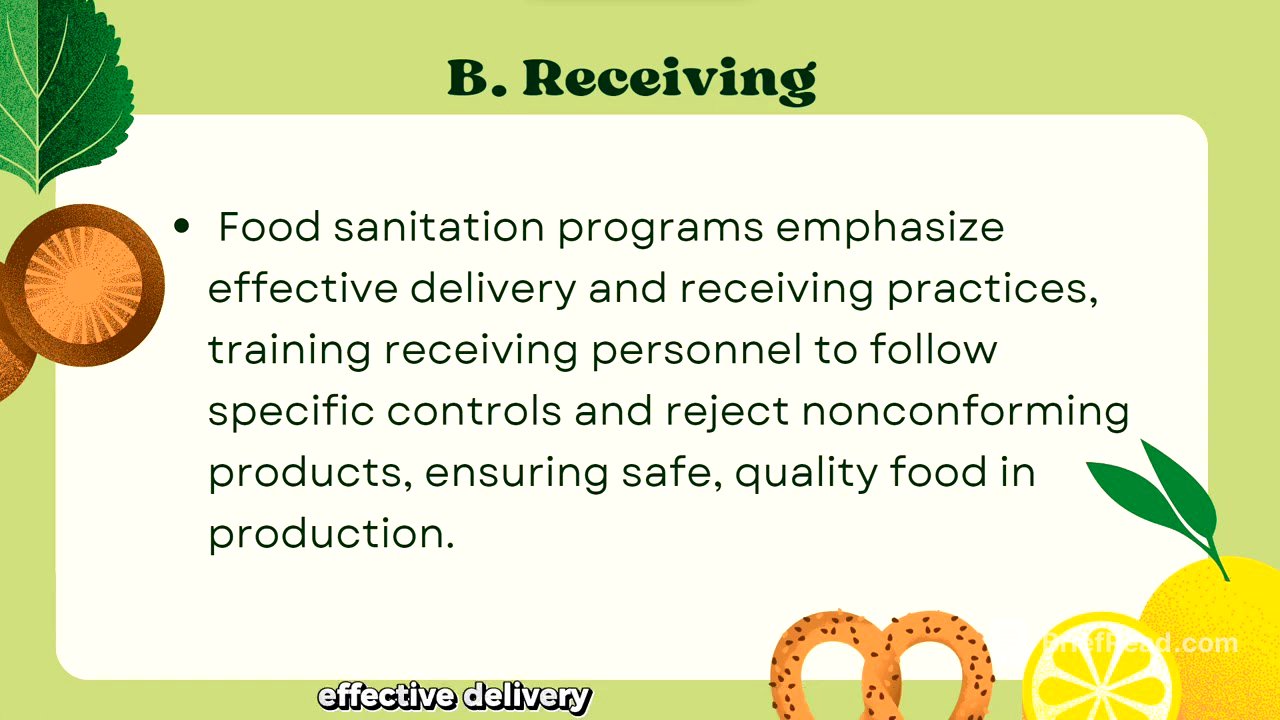TLDR;
This video explains the critical stages of food flow in retail and food service establishments, emphasizing food safety from purchasing to serving. It highlights the importance of selecting approved suppliers, inspecting deliveries, and adhering to strict sanitation guidelines. The video also covers specific guidelines for purchasers and suppliers, temperature control, and detailed receiving procedures for various food types to ensure food safety and quality.
- Importance of food safety from purchasing to serving.
- Guidelines for selecting suppliers and inspecting deliveries.
- Temperature control and receiving procedures for different food types.
Introduction [0:04]
The video introduces the topic of food flow in retail and food service, outlining the learning outcomes: identifying food flow stages, discussing the concept of food flow, and proposing control measures. Key terms are defined, including "thawing" (the process of ice becoming liquid), "food vendor" (a legitimate food supplier), and "Mise en Place" (a French term for preparing ingredients before cooking).
Food Flow Overview [1:40]
The food flow summarizes the journey of food from entering an establishment to being served. It begins with purchasing and receiving, where potential food safety hazards can be avoided by using approved suppliers and inspecting products. The discussion references the US Food Code 2017 and Philippine administrative order number 153 series of 2004, emphasizing sanitation principles in all stages, including receiving, inspecting, transporting, preparing, manufacturing, packaging, and storing food. Contaminated food must be rejected or reprocessed.
Purchasing Food Supply [3:35]
Purchasing food aims to provide unadulterated and safe food that meets specific standards for the menu. While food safety is the supplier's primary responsibility, the food establishment must also safeguard incoming food items. The management should select suppliers wisely, ensuring they comply with local ordinances, the Philippine Sanitation Code, and the Philippine Food Safety Act of 2013. Suppliers should implement standard sanitation operating procedures, have a quality assurance system, use refrigerated vans with temperature monitoring, train employees in food sanitation, deliver food in intact packaging, and implement a food safety management system.
Guidelines for the Purchaser [5:20]
Purchasers should establish a food delivery schedule, communicate food quality standards, prepare receiving guidelines, ensure delivery personnel have health cards, conduct quality audits and food safety inspections, ensure organized and clean food storage within standard temperatures, schedule refrigerator and freezer maintenance, and reject non-compliant food deliveries.
Receiving [6:23]
Effective delivery and receiving practices are fundamental to food sanitation. The person in charge of receiving must be trained to receive food deliveries based on specified controls and empowered to reject non-conforming products. This ensures that only safe food of appropriate quality is used in production.
Food Safety Guidelines for Receiving [6:52]
Raw materials and other ingredients must be handled sanitarily, inspected, and segregated to ensure they are clean and suitable for processing. Raw materials should be stored under conditions that protect against contamination and minimize deterioration. Containers and carriers should be inspected upon receipt. Raw materials should not contain harmful levels of microorganisms or must be treated to eliminate them. Compliance should be verified through supplier guarantees and certifications. Rework items should be held in containers that protect against contamination and identified for reprocessing. Frozen raw materials must be kept frozen, and thawing should prevent contamination.
Receiving Temperature Guidelines [9:08]
Refrigerated Time/Temperature Control for Safety (TCS) food should be at 5°C (41°F) or below when received, unless otherwise specified by law. Raw eggs should be received in refrigerated equipment maintaining an ambient air temperature of 7°C (45°F) or less. TCS food cooked and received hot should be at 57°C (135°F) or above. Frozen food should be received frozen with no signs of thawing.
Receiving Do's and Don'ts [10:47]
Dry foods shipped in cartoons, bags, or pails should be checked for damage and leakage. Sealed cartoons showing signs of being opened should be verified. Canned goods should be inspected for swelling and large dents, which indicate spoilage or contamination. Dairy products should be checked for the "best before" date and intact packaging, and unpasteurized milk should never be purchased. Produce should be checked for ripeness, freshness, quality, and signs of insect infestation. Meats, poultry, and seafood should be checked for leaking vacuum packages and proper grading or sanitary certificates. Frozen products should be inspected for freezer burn, torn wrappings, or partial thawing.









